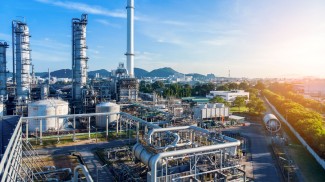Congress’s $369 billion climate and energy investment plan—part of the Inflation Reduction Act set for a final vote in the U.S. House on Friday—includes provisions that can accelerate step-change greenhouse gas (GHG) emissions reductions from industry. It is crucial to spur these reductions, as industry emits more than a quarter of total U.S. GHG emissions.
A key to the industrial decarbonization effort in the bill is a $5.8 billion Advanced Industrial Facilities Deployment Program (AID for short) that will accelerate deployment of advanced industrial decarbonization technologies. Housed in the Department of Energy (DOE), this program will provide companies grants or loans for up to 50% of the cost of deployment of low-carbon-emitting technologies directly involved in industrial processes of energy-intensive industries.
Achieving net-zero GHGs in industry by 2050 will take trillions of dollars of investments from the private sector, government, and the finance community. Companies are understandably hesitant to take on these enormous technical and financial risks. The government cost-sharing provided by AID will help companies make the investments to bring transformative, low-carbon production processes to commercial scale.
Funds Could Spur Low-Carbon Process Technology
AID targets support for technologies “directly involved in an industrial process” that are “designed to accelerate greenhouse gas emissions reduction progress to net-zero.” This can include technologies that generate and spur the use of low-carbon process heat (today, process heat is responsible for 50% of the energy used in industry).
Congress also directed the program to support the incorporation of sustainable chemistry and engineering practices and approaches that use materials and energy effectively, decrease health and environment impacts, reduce waste, and make recycling and reuse easier. And the program will fund improvements in the energy and materials efficiency of processes at a more holistic, broader scale, using smart manufacturing, information technology, and high-performance computing approaches.
Examples of low-carbon process technology innovations that could gain support from AID include low-GHG processes for the manufacture of steel such as direct reduction iron (DRI) using hydrogen made from renewable electricity. Application of this technology at scale could reduce CO2 emissions some 95% versus a conventional process. That’s a big deal, as iron and steel production accounts for 7% of U.S. industrial emissions at 90 million metric tons per year. Direct reduction using a molten oxide at high temperature or aqueous bath at low temperature via electrolysis—both emerging technologies in research, development, and deployment (RD&D) —could use less electricity than current DRI.
In the chemicals sector, examples now in RD&D could include scaling the electric crackers for generating ethylene from ethane. These processes could slash CO2 emissions from ethane production by more than 50%. That’s also a big deal, as ethane crackers alone account for 47 million metric tons per year of CO2 emissions.
Step-change innovations in process technology are also needed to complement the pursuit of energy efficiency, electrification (with electricity from low-carbon sources), hydrogen and other low-carbon fuels and feedstocks, and carbon capture, utilization, and storage. Even with the aggressive pursuit of these decarbonization pillars, it is likely that additional approaches will be needed to help tackle the remaining 10%–20% of GHG emissions from industry. Deployment of low-carbon process technology, with early demonstrations at scale supported by AID, can help address this gap.
Demonstration of low-carbon process technologies at scale will help accelerate the dispersion of these technologies throughout industry. When it is proven that these low-carbon process technologies are viable at scale, benefits beyond carbon reductions (improved production flexibility, quality, lower wastes) could be realized. This will also create market pull for the low-carbon approaches associated with the pillars noted above. For example, deployment at scale of electric crackers could accelerate use of low-carbon electricity in industry. Demonstration of DRI with renewable hydrogen could increase its market pull, lowering cost and increasing scale.
Bill Will Help Companies Make the Difficult Leap to Low-Carbon Technologies
Deployment of low-carbon technologies at industrial scale can be very costly. A direct reduction iron facility installed by Cleveland Cliffs in Toledo cost well over $1 billion, and although it is ready for hydrogen, the integration with renewable hydrogen has not yet occurred. Ethane crackers cost $1–1.5 billion. The first installation of an electric cracker at scale would be even more expensive. Few single corporations would risk the company on developing and deploying a low-carbon technology by themselves. The AID funding provides cost sharing to help cover engineering costs and reduce risks for the first few low-carbon technology deployments. In the process it will encourage companies to work together in consortia to deliver these challenging advances.
AID can help spur the revolutionary changes needed to manufacture the low-carbon products called for by customers, and support the push by some states and the federal government to preferentially procure low-carbon materials. This aligns with provisions in the bill to support labeling for low–embodied carbon products. The bill also expands the 48C manufacturing tax credit and DOE’s loan guarantee program, supporting further deployment of these technologies.
The investments in AID can jump-start industry’s drive to process innovation and to net-zero GHGs—and that’s exactly what we need.

